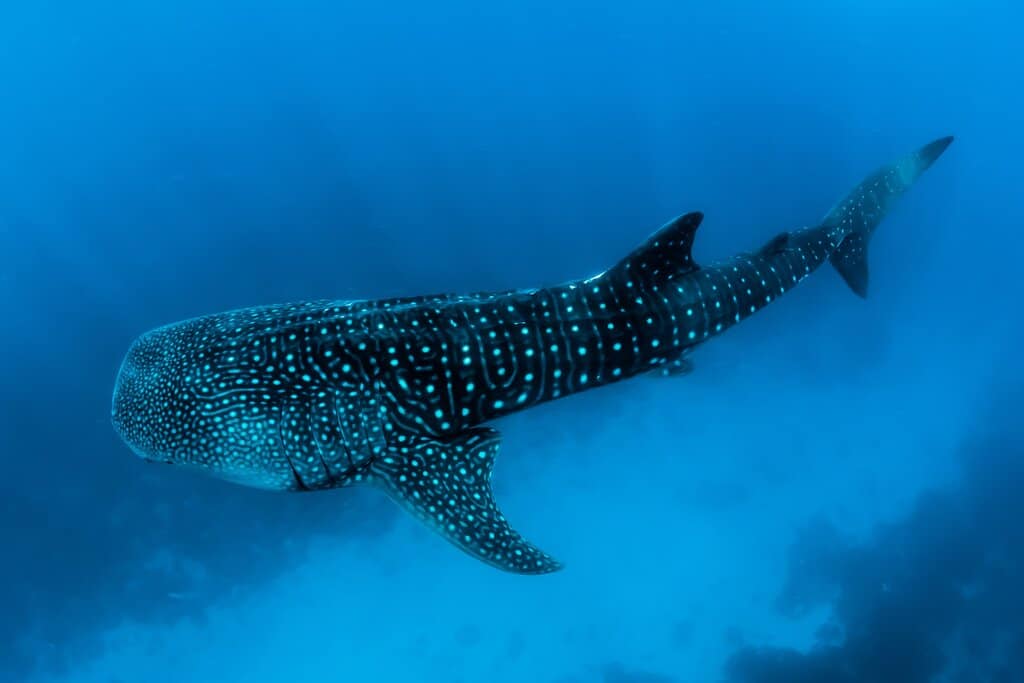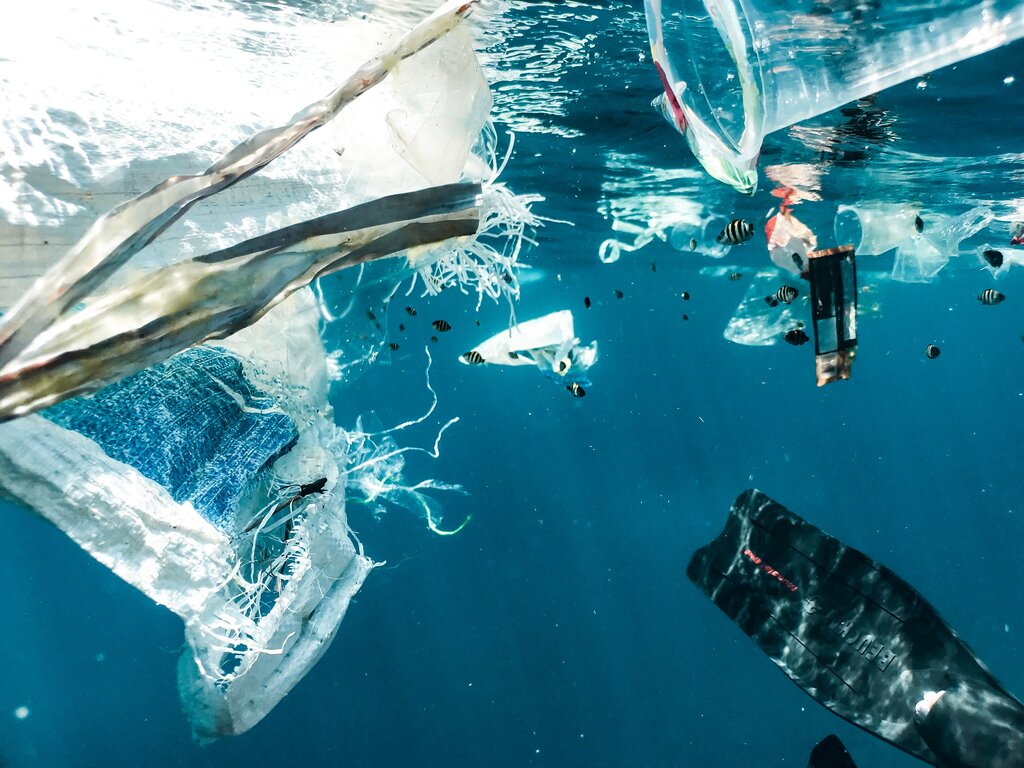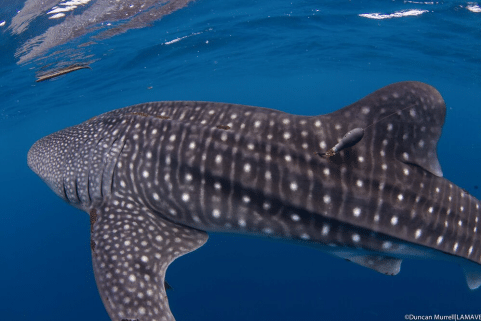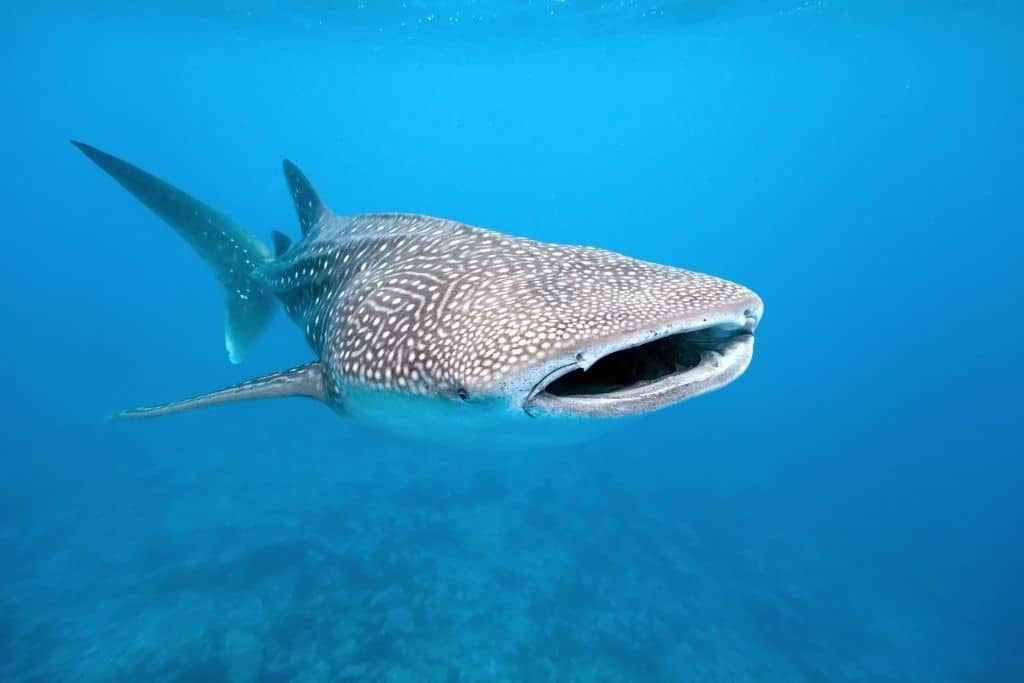Whale sharks are found broadly across tropical and warm temperate seas, with major subpopulations in the Atlantic Ocean and the Indo-Pacific Ocean. These gentle giants can reach a length of 12 metres, and a weight of 19,000 kilograms, thus rightfully earning their place as the holders of three world records: the largest species of shark; the largest species of fish; and the largest non-mammalian vertebrate. Despite their dimensional similarity to whales, the resemblance more or less ends there, as whale sharks breathe through their gills as opposed to surfacing for air. Although less than 10% of whale sharks born reach adulthood, their lifespan ranges from 70 to 150 years old.
—
Family: Rhincodontidae
Genus: Rhincodon
Species: Rhincodon typus
IUCN Status: Endangered
Population: 100,000 – 200,000
1. Feeding Habits
Whale sharks are one of three known filter-feeding shark species, the others being the basking shark and the megamouth shark. Therefore, despite having 300 rows of tiny teeth measuring
approximately six millimetres in length, whale sharks cannot bite or chew their food. Instead, these magnificent creatures open their mouths to a gaping 1.2 metres, and ingest any prey that falls into their path. This includes plankton, shrimp, schooling fish, squid, crabs, fish larvae, and jellyfish.
Feeding typically occurs through one of two methods: surface ram filtration, whereby the animal actively swims forwards on the surface of the water with 85% of their mouth submerged; and suction filter-feeding, in which the whale shark opens and closes its mouth in order to create suction, thus draw higher volumes of water and prey into its mouth. The pharyngeal cavity of the whale shark (the opening to the oesophagus) is occluded by a specialised filtration system, consisting of filtering pads called gill rakers. These essentially filter out any food through a fine net, sending it to the back of the throat, whilst expelling water through the gills. If any residue happens to clog their filtration pads, whale sharks will “cough” to clear the particles.
Despite averaging a pace of 5 kilometres per hour, whale sharks manage to travel approximately 24 to 28 kilometres per day to source enough food to sustain themselves. Individuals spend approximately 7.5 hours per day foraging and consume around 2,763 grams of plankton per hour.

Another special characteristic of these incredible creatures is their distinctive white spotted and striped pattern, which is as unique to each individual whale shark as a human fingerprint. Due to the fact that the whale shark is a pelagic species (one that lives in the open seas), its light spotted pattern has long perplexed scientists; it is a feature typically seen on bethnic species (bottom-dwellers) as a form of camouflage, as the disruptive colouration makes it harder for predators to detect their outline.
Most theories suggest that whale sharks sport this unusual pattern due to their evolutionary relatedness to bottom-dwellers. Whale sharks belong to the Orectolobiformes order, otherwise known as “carpet sharks”, aptly named after their carpet-like mottled patterns. Among the 40 odd species that are categorised under this order, the majority are bethnic species. Thus, some view the whale shark’s markings as a vestigial remnant of the species’ evolutionary past, whilst others argue that the camouflaging properties of the markings continue to serve whale sharks despite their pelagic nature.
Other theories suggest that the spots help deflect ultraviolet rays whilst whale sharks perform surface feeding, or that the patterns are a form of intraspecific communication.
2. Services
Due to their extensive geographical distribution and sheer size, these gentle, sentient beings also provide numerous ecological functions to their surrounding ecosystems.
As aforementioned, whale sharks inhabit warm, tropical oceans, which are usually low in productivity and nutrients. Due to their dynamic feeding habits and migratory nature, the frequent and often forceful vertical and horizontal movements performed by whale sharks create small oceanic currents. In turn, these streams act as important vectors for transporting nutrients from areas of high productivity, such as coastal waters and the mesopelagic zones of oceans (200 to 1,000 meters in depth), to nutrient-poor tropical seas. This contributes greatly to the resilience of tropical marine ecosystems.
By virtue of their immense size, whale sharks also provide habitat and shelter for smaller sea creatures, such as remoras, pilot fish, and golden trevally fish. Additionally, they maintain a mutually beneficial relationship with tuna, which swims beneath whale sharks in small schools as they work in tandem to create “bait balls”: a dense swarm of small prey which both predators can share.
Most incredibly, the humble whale shark continues to serve its ecosystem even after its passing. As whale sharks sink to the ocean floor after death, the carcasses provide habitat and sustenance to a myriad of bethnic organisms. The lengthy decomposition process spans several decades, allowing hundreds of sea creatures and macro-fauna to utilise the carcass for nutrition and inhabitation.
3. Threats
Despite their service to surrounding environments and ecosystems, the whale shark has been listed as ‘Endangered’ under the International Union for Conservation of Nature (IUCN) Red List since 2016. Studies on its population estimates, as well as habitat availability, indicated a population decline of 40-92% across differing geographical subpopulation habitats. In the Indo-Pacific region, where approximately 75% of all whale sharks remain, a decline of 63% was inferred over a period of 75 years (approximately three generations). As with the majority of marine life, major threats to the welfare and protection of whale sharks are anthropogenic in origin, with the fishing industry proving to be a prime menace.
Despite the closure of several whale shark fisheries in the 1990s and 2000s, whale shark products remain a valuable, highly demanded commodity in Asian markets. They are captured for their meat and fins, which are considered to be a delicacy in certain Asian cultures, as well as their oil for waterproofing boats. Countries such as China and India continue to hunt the species, notwithstanding the widespread ban on whale shark hunting, as well as the fact that both states are signatories of the Convention on International Trade in Endangered Species (CITES). In China, up to 600 whale sharks are hunted yearly to supply a single factory. In response to backlash regarding their lack of regulation on the illegal trade of whale shark products, Chinese fisheries authorities claimed that they lack the resources to cease the practice.
While many commercial fishing vessels do not actively seek to capture whale sharks, the reckless, and often dangerous fishing techniques utilised by fishermen result in their capture as bycatch. As aforementioned, whale sharks and tuna have a mutualistic relationship and are often found in close proximity. This has resulted in fishermen using the presence of whale sharks to locate schools of tuna, with some even setting purse-seine nets around whale sharks to maximise the quantity of tuna caught.

Apart from fishing vessels, cargo ships travelling through shipping lanes also pose a great risk of injury and death to whale sharks, in addition to degrading their habitat with traffic and noise pollution. Due to the fact that whale sharks habitually feed on, or just below, the surface of the water, large cargo ships and fast-moving vessels often fail to notice their presence. Propellor injuries are thus commonplace, with fatalities seldom being reported. Whale-watching tour boats also fail to approach whale sharks with caution, similarly threatening their welfare with propellor accidents, or disrupting their feeding habits.
As a filter-feeder, the whale shark is also at greater risk of ingesting toxic or indigestible pollutants that have plagued marine life for years. Studies in Indonesia have indicated that whale sharks potentially swallow hundreds of microplastic particles per hour whilst feeding on plankton. Other debris, such as cans, bottles, ghost nets, and sediment run-off from coastal development similarly pose a threat of illness, injury, or entanglement to whale sharks when feeding.
4. Conservation Efforts
The IUCN’s Green Status Assessment on whale sharks indicates that the species remains ‘Largely Depleted’ as of 2021, with a species recovery score of 29%. Although conservation efforts are a relatively recent development, the IUCN determines that the species has a high recovery potential, reaching full recovery within 100 years if protection initiatives are sustained.
One area with tremendous potential for the implementation of long-term conservation initiatives is the whale shark tourism industry. In Mexico, revenue derived from whale shark tours in 2013 reached approximately USD$7 million, whilst in Australia the figure stood at AUD$6 million in 2006. Globally, the whale shark tourism industry is estimated to be worth over USD$42 million per annum, with tourist numbers growing rapidly in certain locations. Due to the increasing lucrativeness of the industry, education campaigns regarding the importance of whale shark conservation have begun to resonate with local communities who once saw the species as a source of food or trade. In the Philippines, fishermen from a poverty-stricken province who once struggled to provide income for their families saw an opportunity to establish a community-based whale shark dive company in 2011, resulting in 750,000 visitors within the first five years of its operation. Despite obvious controversies, studies have shown that the increased focus on tourism has contributed to the safeguarding of whale sharks, with locals recognising the inherent value of the species and its environment. With education programmes and codes of conduct ensuring the maintenance of safe distances between boats, tourists and whale sharks, communities can minimise the risk of disturbance and injury to the species.
Apart from local communities, further education campaigns are also needed for fishermen with regards to sustainable fishing practices and safety procedures in the event of accidental bycatch. While most Regional Fisheries Management Organisations (RFMOs) prohibit the use of purse-seine nets on whale sharks, 73% of bycatch incidents involving purse-seine nets are not intentional. Training programmes and regulative procedures on the safe release of accidental bycatch are therefore required to ensure fishermen do not cause fatalities when attempting to untangle animals from nets. Recent improvements in bycatch-reducing net technology, such as nets fitted with deliberate weak points, can also assist in reducing injuries.
The rise in tourist, fishing, and shipping vessel traffic also needs greater regulation, as ship strikes, propeller accidents, noise pollution, and feeding disturbances pose an ever-increasing threat to the highly migratory whale shark. By mapping known feeding locations, migration routes, and frequently travelled corridors, relevant authorities can make well-informed decisions when designating shipping lanes, fishing locations, and “go-slow” zones. Consequently, global political cooperation is a necessity for effective conservation as whale sharks cross political boundaries in international waters.
The whale shark is listed as a protected species under several international conventions and treaties, including: Annex I (Highly Migratory Species) of the United Nations Convention on the Law of the Sea (UNCLOS); Appendix II of the Bonn Convention for the Conservation of Migratory Species of Wild Animals (CMS); and Appendix II of the Convention on International Trade in Endangered Species (CITES). National bans on shark fishing, or specifically on whale shark hunting, have also been implemented in over 45 countries. Regardless, illegal fishing and trade businesses remain operative in several regions, with China in the lead with local consumption and exports. Renewed conservation initiatives and enforceable sanctions for non-compliance are therefore required to incentivise regional authorities to quell illegal operations.

Whale shark tagged by LAMAVE for monitoring. Photo by Duncan Murrell for LAMAVE
NGO Spotlight
Thankfully, numerous conservation groups are working tirelessly to implement conservation goals and raise global attention. At the forefront are local NGOs, such as the Large Marine Vertebrates
Research Institute of the Philippines (LAMAVE), who have successfully completed several conservation initiatives for the whale shark population of the Philippines. In addition to conducting extensive scientific research into the biological, behavioural and ecological profile of whale sharks to garner a better understanding of effective conservation strategies, political lobbying and public awareness campaigns have aided in the cultivation of positive, conservationist sentiments amongst local communities towards the environment. Some of their notable achievements include: the publication of 15 scientific research papers on whale shark behaviour; the monitoring of 39 whale sharks through satellite tagging; managing the national catalogue for whale sharks; as well as holding an advisory position for the drafting and eventual passing of local ordinances regulating the whale shark tourism industry in certain provinces.
What Can You Do?
There are several ways in which you can show your support for whale shark conservation efforts within your local community:
- Stop buying single-use plastics. Find a nice water bottle and take it with you to work, school and everywhere in-between. Carry a few reusable shopping bags with you when you go out. Opt for a straw-less drink. Use Tupperware for takeaways.
- Get involved with beach clean-ups. Although the single-use plastics you pick up on the beach are only a very small percentage of all the rubbish strewn across the planet’s oceans, every little piece makes a difference in reducing the amount of microplastics out there.
- Reduce your seafood consumption. The effects of overfishing and unethical fishing practices have acquired considerable media attention since the release of documentaries such as Seaspiracy. Learn where your seafood is coming from, and perhaps try experimenting with plant-based alternatives. Avoid any products containing shark meat, fins or oils; this includes shoe varnish, polish for waterproofing wood, and skin-care products.
- Support local and international NGOs. Organisations such as LAMAVE, the Maldives Whale Shark Research Programme, and Whale Shark Mexico provide numerous opportunities for volunteer work, citizen science projects, or simply for donations to fund their research, education initiatives, or campaigns for raising awareness.
- Practice responsible tourism. When visiting coastal countries that offer whale watching tours, ensure that the tour you select is ethical and sustainable, with minimal animal contact and well-informed guides.
If you want to learn more about endangered species, make sure to check out other articles from our Endangered Species Spotlight Series




















